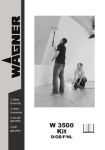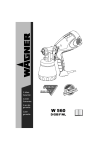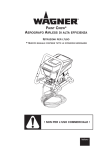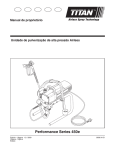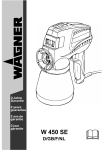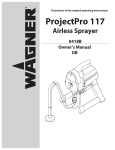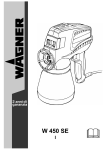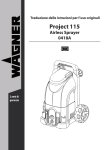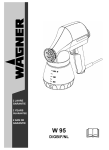Download WAGNER Project 115 Owner`s manual
Transcript
® Project 115 Airless Sprayer Betriebsanleitung • Owner’s Manual Manuel d’utilisateur • Gebruikshandleiding D F ..........2 GB . . . . . . . . . . 10 D GB . . . . . . . . . . 18 NL . . . . . . . . . . 26 F NL 1 A F H G B I C D CLEAN ROLL PRIME E 2 3 d) c) 1) 2) (a) b) a) X2 (b) L 4 5 2) (a) 3) 1) O PRIME 2) (e) X2 6 1) 7 R 8 (a) (b) 9 10 2) l 1) (b) (a) PRIME 11 12 2) 1) 3) (a) (b) PRIME l 13 B) A) 25 - 30 cm C) 25 - 35 cm D) 25 - 30 cm 25 - 30 cm 14 15 A) B) 16 1) 3) 2) A) B) 17 (a) (b) 18 (g) (e) (f) (d) (a) (c) (b) 19 20 1 2 3 (a) 4 21 5 6 7 (a) 8 9 10 22 1 2 4 3 Project 115 - Safety Information Warning! Attention: Danger of injury by injection! Airless units develop extremely high spraying pressures. Danger 1 Never put your fingers, hands or any other parts of the body into the spray jet! Never point the spray gun at yourself, other persons or animals. Never use the spray gun without safety guard. Do not treat a spraying injury as a harmless cut. In case of injury to the skin through coating materials or solvents, consult a doctor immediately for quick and expert treatment. Inform the doctor about the coating material or solvent used. 2 The operating instructions state that the following points must always be observed before starting up: 1. Faulty units must not be used. 2. Secure WAGNER spray gun using the safety catch on the trigger. 3. Ensure that the unit is properly earthed. The connection must take place through a correctly earthed two-pole and earth socket outlet. 4. Check allowable operating pressure of high-pressure hose and spray gun. 5. Check all connections for leaks. 3 The instructions regarding regular cleaning and maintenance of the unit must be strictly observed. Before any work is done on the unit or for every break in work the following rules must be observed: 1. Release the pressure from spray gun and hose. 2. Secure the WAGNER spray gun using the safety catch on the trigger. 3. Switch off unit. Be safety-conscious! 10 Project 115 - Safety Information U All local regulations in force must be observed. For secure handling of Airless high-pressure spraying units the following safety regulations are to be observed: U U U U U Caution! Danger of injury through injection! Never point the spray gun at yourself, other persons or animals. Never use the spray gun without spray jet safety guard. The spray jet may not come into contact with any part of the body. All hoses, fittings, and filter parts must be secured before operating spray pump. Unsecured parts can eject at great force or leak a high pressure fluid stream causing severe injury. In working with Airless spray guns, the high spray pressures arising can cause very dangerous injuries. If contact is made with the spray jet, coating material can be injected into the skin. Do not treat a spray injury as a harmless cut. In the case of injury to the skin through coating material or solvents, consult a doctor for quick and correct treatment. Inform the doctor about the coating material or solvent used. Electrostatic charging (formation of sparks or flame) Danger U Under certain circumstances, electrostatic charging can occur on the unit due to the rate of flow of the coating material when spraying. On discharging this can result in the emergence of sparks or fire. It is therefore necessary that the unit is always earthed through the electrical installation. The connection must take place through a correctly earthed two-pole-and-earth socket outlet. Using unit on construction sites Connection to the mains only through a special feed point, e.g. through an error protection installation with INF ≤ 30 mA. U Secure spray gun against unintended operation Setting up the unit When working indoors: Vapors containing solvents may not be allowed to build up in the area of the device. Setting up the unit on the side a way from the sprayed Danger object. A minimum distance of 5 m between the unit and spray gun is to be maintained. Always secure the spray gun when mounting or dismounting the tip and in case of interruption to work. For reasons of function, safety and durability use only original WAGNER high-pressure hoses. i Danger of injury through the spray jet Recoil of spray gun Danger High-pressure hose (safety note) Electrostatic charging of spray guns and the high-pressure hose is discharged through the high-pressure hose. For this reason the electric resistance between the connections of the high-pressure hose must be equal or lower than 197 kΩ/m (60 kΩ/ft.). There may be no sources of flame such as, for example, open fires, smoking of cigarettes, cigars or tobacco pipes, sparks, glowing wires, hot surfaces, etc. in the vicinity. Danger U Max. operating pressure Max. permissible operating pressure for spray gun, spray gun accessories and high-pressure hose may not fall short of the maximum operating pressure of 200 bar (20 MPa) stated on the unit. Do not use the unit in work places which are covered to the explosion protection regulations. U U Prevention of occupational illnesses Protective clothing, gloves and possibly skin protection cream are necessary for the protection of the skin. Observe the regulations of the manufacturer concerning coating materials, solvents and cleaning agents in preparation, processing and cleaning units. Danger of explosion and fire through sources of flame during spraying work Danger U Only use coating materials with a flash point of 21 °C or above without additional heating. The flash point is the lowest temperature at which vapors develop from the coating material. These vapors are sufficient to form an inflammable mixture over the air above the coating material. Explosion protection Danger U Wear respiratory protection when spraying. The user must be provided with a breathing mask. Flash point Danger Respiratory protection for protection against vapors of solvents In case of high operating pressure, pulling the trigger can effect a recoil force of up to 15 N. If you are not prepared for this, your hand can be thrust backwards or your balance lost. This can lead to injury. 11 Project 115 - Safety Information U When working outdoors: Vapors containing solvents may not be allowed to blow toward the unit. Note the direction of the wind. Set the unit up in such a way that vapors containing Danger solvents do not reach the unit and build up there. A minimum distance of 5 m between the unit and spray gun is to be maintained. U Cleaning units with solvents Danger U Cleaning the unit Ventilation when spraying in rooms Adequate ventilation must be guaranteed for the removal of the solvent vapors. U Danger Suction installations U These are to be set-up by the user of the unit according to local regulations. U When cleaning the unit with solvents, the solvent should never be sprayed or pumped back into a container with a small opening (bunghole). An explosive gas/air mixture can be produced. The container must be earthed. Danger of short circuit through penetrating water! Never spray down the unit with high-pressure or high-pressure steam cleaners. Work or repairs on the electrical equipment Only have this work carried out by a qualified electrician. No liability will be taken for incorrect installation. Earthing of the object U The object to be coated must be earthed. Working on electrical components Remove the mains plug from the socket for all such works. Components and Description The shipping carton for your painting system contains the following: • Spray gun with two filters (M in gun and one XS-S and one M separate) • Two wheel assemblies (including 2 metal covers and 2 plastic covers) • 7.5 m, 1/4” internal diameter pressure hose • An assembly aid (positioned beneath the hopper) • One axle, two axle plates and four screws • Spray tip assembly • One inlet valve pusher tool • Instruction manual Figure 1 - Controls and Functions (further, detailed descriptions of the individual items can be found in the relevant section of the operating instructions) Item A) B) C) D) E) F) G) H) I) ComponentDescription. Description Extendable handle........................The handle extends for easy transport and storage. Removable Hopper.......................The hopper can be removed for easy emptying and cleaning. It can be removed when empty or when filled with material. Do not exceed 9.5 liters. The cover of the hopper does not seal, therefore material can emerge from the upper container if too much material is put in or the hopper tips up. ON / OFF Switch.............................The ON/OFF switch turns the power to the sprayer on and off (O=OFF, l=ON). PRIME / SPRAY Knob.....................The PRIME/SPRAY knob directs fluid to the spray hose when set to SPRAY or the return tube when set to PRIME. The arrows on the PRIME/SPRAY knob shows the rotation directions for PRIME and SPRAY. The PRIME/SPRAY knob is also used to relieve pressure built up in the spray hose (see Pressure Relief Procedure). Project Control................................Project Control functions: Prime, Clean/Roll, Spray 1 - MAX Spray. Return Tube.....................................Fluid is sent back out through the return tube to the original container when PRIME/SPRAY knob is in PRIME position. Handle lock......................................The handle lock allows the extendable handle to extend or contract. Spray Gun.........................................For application of the coating material and regulation of the pump capacity. Spray Hose.......................................The spray hose connects the gun to the pump. 12 Project 115 Assembly Figure 8 - Removing / Emptying the Hopper Figure 2 - Assembling the Wheels 1. Slide the spacer (a), the wheel (b) and the push nut (c) over the end of the axle in the order shown. Make sure the spacer (a) is oriented so the lipped side will face toward the middle of the axle. i i i You will need to stand the axle vertically on a flat and stable surface to assemble the wheels. 2. Lightly tap the assembly aid (d) with a mallet to secure the push nut (c) over the end of the axle. Repeat steps for other wheel. Figure 3 - Assembling the Axle 1. Slide both ends of the axle up into the slots (a) as shown. The lipped side of the spacers (b) should go inside of the axle slots. 2. Make sure each axle plate is oriented and located as shown (L and R). Secure each plate with two (2) screws. Snap the wheel caps (e) over the ends of the push nuts. 1. Screw the thread of the high-pressure hose onto the spray hose connection. Tighten with an adjustable wrench. 2. Thread the other end of the hose to the spray gun. Grip the spray gun with an adjustable wrench on the handle, and tighten the hose nut with the other. The spray tip should not be attached until after the sprayer and spray hose have been purged and primed. Before You Begin Figure 6 - Locking the Spray Gun Always lock the trigger off when attaching the spray tip or when the spray gun is not in use. Be sure to follow the Pressure Relief Procedure when shutting the unit off for any purpose. This procedure is used to relieve pressure from the spray hose. 1. Lock the spray gun off. Flip the ON/OFF switch to the OFF position. 2. Turn the PRIME/SPRAY knob to PRIME. i 3. Switch the pump to OFF. Remove the return tube from the waste container and insert it into the notch in the hopper lid. 4. Remove hopper lid. Fill your hopper with the material you plan to spray. Do not exceed 2 1/2 gallons (b). 5. Switch your unit ON once more and make sure that material is flowing from the return tube. Turn pump OFF and replace the hopper lid. i Figure 7 - Pressure Relief Procedure Any fluids remaining in the pump and the return tube will flow out of the return tube. Let the pump run until no fluid is coming from the return tube. Figure 10 - Releasing the Inlet Valve 1. The gun is secured when the trigger lock is at a 90° angle (perpendicular) to the trigger in either direction. Danger 1. Pull the return tube from the hopper and hold it over a waste container. 2. Turn the PRIME/SPRAY knob to PRIME. Plug in the sprayer. Press the ON/OFF switch into the ON position (I). i Danger The hopper can be heavy when filled with spraying material. Make sure to lift with your legs and not your back in order to reduce the risk of injury. Figure 9 - Priming the Sprayer 1. To assemble the handle, press the button (a) as shown and slide the handle into the cart assembly. 2. Once the handle is fully inside the cart, release the button and pull the handle until it locks in up or down position. i Perform Pressure Relief Procedure. Pull the return tube (a) from the rear of the hopper lid. Grab hopper by the side handles (b) and gently pull it out. When finished emptying / cleaning, replace hopper and hopper lid. 5. Replace the return tube by inserting it through the notch in the hopper lid. Purging and Priming Figure 5 - Attaching the Hose Always place the hopper on a hard, flat, stable surface when removed. 1. 2. 3. 4. Danger Figure 4 - Assembling the Handle Make sure your floors and furnishings are protected with drop cloths to avoid property damage. Take care not to pinch your fingers when turning the switch. 3. Unlock the spray gun and trigger spray gun into the side of the material bucket. Lock the spray gun. 13 If spray material does not flow from the return tube, the inlet valve may be stuck. Follow these steps. 1. Shut the unit OFF and unplug. 2. Carefully remove the hopper. Clean the connection area between the hopper and the basic unit. 3. Insert the inlet pusher tool (a) into the center of the inlet valve area (b). This should release the inlet valve and allow spraying material to flow through the return tube. 4. Replace hopper and return tube and resume. Project 115 Figure 11 - Priming the Spray Hose i Figure 14 - Practice 1. Be sure that the paint hose is free of kinks and clear of objects with sharp cutting edges. 2a. If you are spraying thicker materials, turn the PRIME/SPRAY knob to MAX SPRAY. 2b. If you are spraying thinner or lighter bodied materials, turn the PRIME/SPRAY knob to SPRAY (1). Keep hands clear from fluid stream. Ground the gun by holding it against the edge of a metal container while flushing. Failure to do so may lead to a static electric discharge which may cause a fire. 3. While pulling the trigger, switch the pump ON (l), and turn the PRIME/ SPRAY knob to Spray (1). Hold the trigger until all air, water, or solvent is purged from the spray hose and material is flowing freely. Danger The spray tip should not be attached to your spray gun when purging your spray hose. 2. PULL the trigger and aim the spray gun at the side wall of a waste container. If using oil-based materials, the spray gun must be grounded while purging (see warning below). Danger i 1. Unlock the spray gun and turn the PRIME/SPRAY knob to PRIME. i If the PRIME/SPRAY knob is still on SPRAY, there will be high pressure in the hose and spray gun until the PRIME/SPRAY knob is turned to PRIME. 4. Release trigger. Turn the prime/spray knob to PRIME. Turn the pump OFF (O). Trigger the gun into the waste container to be sure that no pressure is left in the hose. Figure 12 - Attaching the Spray Tip Danger POSSIBLE INJECTION HAZARD. Do not spray without the tip guard in place. Never trigger the gun unless the tip is in either the spray or the unclog position. Always engage the gun trigger lock before removing, replacing or cleaning tip. Figure 15 - Unclogging the Spray Tip i Danger When attaching the tip guard to the gun, align the tip guard as shown in figure 12 (a), then tighten by hand (b). Spraying A) The key to a good paint job is an even coating over the entire surface. Keep your arm moving at a constant speed and keep the spray gun at a constant distance from the surface. The best spraying distance is 25 to 30 cm between the spray tip and the surface. B) Keep the spray gun at right angles to the surface. This means moving your entire arm back and forth rather than just flexing your wrist. C) Keep the spray gun perpendicular to the surface, otherwise one end of the pattern will be thicker than the other. D) Trigger gun after starting the stroke. Release the trigger before ending the stroke. The spray gun should be moving when the trigger is pulled and released. Overlap each stroke by about 30%. This will ensure an even coating. If the spray pattern becomes distorted or stops completely while the gun is triggered, follow these steps. Do not attempt to unclog or clean the tip with your finger. High pressure fluid can cause injection injury. 1. Release the trigger and lock the gun off. Rotate the reversible tip arrow 180º so that the point of the arrow is toward the rear of the gun (see figure 15). i Figure 13 - Spraying Technique i The paint hose should stiffen as material begins to flow through it. 3. Unlock the spray gun. 4. While pointing the gun at a piece of scrap wood or cardboard, trigger the spray gun to bleed air out of the hose. 5. When material reaches the spray tip, spray a test area to check the spray pattern. 6. Use the lowest pressure setting necessary to get a good spray pattern (A). If the pressure is set too high, the spray pattern will be too light. If the pressure is set too low, tailing will appear or the paint will spatter out in blobs rather than in a fine spray (B). 1. Lock the spray gun off. 2. Thread the tip guard onto the gun. i If you expect to be away from your spray project for more than 1 hour, follow the Short Term Cleanup procedure described in the Cleanup section of this manual. Under pressure, the spray tip may be very difficult to turn. Turn the PRIME/SPRAY knob to PRIME and trigger the gun. This will relieve pressure and the tip will turn more easily. 2. Turn the prime/spray knob to spray. 3. Unlock the gun and squeeze the trigger, pointing the gun at a scrap piece of wood or cardboard. This allows pressure in the spray hose to blow out the obstruction. When the nozzle is clean, material will come out in a straight, high pressure stream. 4. Release the trigger and lock the gun off. Reverse the tip so the arrow points forward again. Unlock the gun and resume spraying. When finished spraying, perform Pressure Relief Procedure. 14 Project 115 Cleanup i If you are using water-soluble materials, use warm suds to clean the spray device. If you are using solventbased spray, use a suitable solvent for cleaning, with a flash point of over 21°C. i Do not use solvents for water-soluble materials, as the mixture will turn into a gel-type substance which is difficult to remove. 12. Let the pump circulate the cleaning solution out the return tube for 2-3 minutes. Turn the pump OFF. 13. Remove and thoroughly rinse the hopper once more. 14. Replace the hopper for storage. Figure 18 - Cleaning the Spray Gun Figure 16 - Short Term Cleanup i Only follow these instructions when using watersoluble materials. If you are using solvent-based spray, follow the Cleanup and Long-Term Storage steps. A) Shutdown 1. Perform the Pressure Relief Procedure (see figure 7) and unplug the sprayer. 2. Pour 1/2 cup water slowly on the top of the paint to prevent the paint from drying. 3. Wrap the spray gun assembly in a damp cloth and place it in a plastic bag. Seal the bag shut. Place the sprayer in a safe place out of the sun for short-term storage. B) Startup 1. Remove the gun from the plastic bag. Stir the water into the paint. 2. Turn the PRIME/SPRAY knob to PRIME. 3. Plug sprayer in. 4. Turn the switch to ON (I). 5. Turn the PRIME/SPRAY knob to MAX SPRAY. Test the sprayer on a practice piece and begin spraying. Figure 19 - Long-Term Storage Figure 17 - Flushing the System 1. Perform Pressure Relief Procedure (see figure 7). 2. Empty the hopper of spraying material (see figure 8). 3. While removed, rinse the hopper with the appropriate cleaning solution until clean. 4. Lock the gun and remove spray tip assembly. Replace the hopper and return tube. Fill the hopper with appropriate cleaning solution. 5. Place a waste container (a) next to the original material container (b). The containers should be touching. Aim the spray gun into the side of the original material container (b) and hold the trigger. 6. While pulling the gun trigger, turn the pump ON (l), and turn the PRIME/ SPRAY knob to SPRAY (1) to purge material from the hose back into the original container. Keep holding trigger through next steps. 7. When cleaning solution flows from the spray gun, keep holding the trigger and aim the spray gun into the side of the waste container (ground gun with a metal container if flushing with flammable solvent). 8. Trigger the gun until the fluid flowing out of the gun is clear. You may need to dispose and obtain new cleaning solution. 9. Turn the PRIME/SPRAY knob to PRIME and trigger gun to relieve pressure. 10. If hopper is empty of all cleaning solution, refill with new cleaning solution. 11. Turn the PRIME/SPRAY knob to PRIME, and turn the pump ON. 1. Make sure the pump is switched OFF (O). Make sure the PRIME/SPRAY knob is turned to PRIME. Unplug the sprayer. 2. Remove spray gun from the paint hose using adjustable wrenches. 3. Unclip the trigger guard (a) from the filter housing (b) by pulling outward from the filter housing. Unscrew the filter housing. 4. Remove the filter (c) from the spray gun housing and clean with the appropriate cleaning solution (warm suds for watersoluble materials, solvents with a flash point of over 21°C for solvent-based substances). 5. Remove spray tip (d) from spray guard assembly. Clean spray tip with a soft-bristled brush and the appropriate cleaning solution. Be sure to remove and clean the washer (e) and saddle seat (f) located in the rear of the spray tip assembly. 6. Replace the cleaned filter, tapered end first, into the gun housing. The tapered end (g) of the filter must be loaded properly into the gun. Improper assembly will result in a plugged tip or no flow from the gun. 7. Install spray tip (d), saddle seat (f) and washer (e), and replace spray guard assembly. 8. Thread the spray gun back onto the paint hose. Tighten with a wrench. 15 1. Remove hopper. Pour approximately two ounces of light household oil into the inlet valve (a). 2. Remove hose from spray hose port. Place a rag over the spray hose port, and turn the switch ON (l). Let the unit run for five seconds. Turn the pump OFF (O). 3. Replace the hopper. 4. Wipe entire unit, hose and gun with a damp cloth to remove accumulated paint. Replace the spray hose. 5. Push handle lock to collapse the handle. Project 115 Parts Lists Figure 20 - Cleaning the Inlet Valve (Kit part number 0418714) i Figure 22 - Spray Gun/Spray Hose Cleaning or servicing the inlet valve may be required if the unit has priming problems. Priming problems may be prevented by properly cleaning the sprayer and following the long-term storage steps. 1. Remove the hopper. Loosen the locknut by turning anticlockwise. 2. Remove the inlet sleeve (1) with a suitable tool (e.g. socket SW 11). 3. Inspect the threads on the inlet sleeve and the inlet sleeve O-ring (2). Remove any accumulated paint. 4. To remove the inlet valve, place the assembly aid (8) on a socket (6) with a 5/8” insert (7). Insert the inlet valve tool into the inlet valve (a). Remove the inlet valve screw connection by unscrewing anticlockwise from the housing. 5. Retrieve the inlet valve (9) and the inlet valve O-ring (10) from the inlet valve housing. Clean or replace and lubricate the O-ring with a light household oil. 6. Set the inlet valve O-ring (10) back into the housing, and set the inlet valve (9) on top of it. 7. Replace inlet fitting (8) into the housing. Tighten with the inlet valve tool (7) and ratchet (4, 5, 6). 8. Replace the seal (3). Place the inlet sleeve O-ring (2) onto the inlet valve fitting (9), and replace the inlet sleeve (1) by twisting it clockwise. 9. Replace the hopper. Part # 0418717 0418705 0418708 0418711 0418712 0418718 Part # 0418705 Description Quantity Gun assembly (without nozzle ).....................1 Tip, XS.......................................................................1 Tip, L..........................................................................1 Filter, XS-S (red)....................................................2 Filter, M (yellow)...................................................2 Spray hose, 7.5m, red.........................................1 Description Spray tip, XS .....................Water-soluble and solvent based enamels and paints, oils and release agents 0418706 Spray tip, S ........................Synthetic resin-based paints, PVC paints 0418707 Spray tip, M . .....................Enamel paints, undercoats, primers, fillers, indoor latex paints and indoor emulsions 0418708 Spray tip, L ........................Enamel paints, undercoats, primers, fillers, indoor latex paints and indoor emulsions, anti-corrosive paints 0418711 Filter, XS - S (red, 2 pack) 0418712 Filter, M (yellow, 2 pack) 0418713 Filter, L - XXL+ (white, 2 pack) 0418714 Valve set (inlet and outlet valve) All spare parts listed above are wear parts, and are not covered by warranty! Figure 21 - Cleaning the Outlet Valve Cleaning or replacing the outlet valve may be necessary if your spray performance remains poor after having performed all the steps contained in the Troubleshooting section of this manual. 1. Unscrew the outlet valve from the outlet valve housing using an adjustable wrench. 2. Inspect the inside of the outlet valve housing (a). Clean any accumulated paint. 3. Replace with a new outlet valve. Tighten into outlet valve housing with an adjustable wrench. Item 1 2 2 3 3 4 16 Project 115 Problem Cause Solution 1. The sprayer is not plugged in. 2. The ON/OFF switch is set to OFF. 3. The sprayer shuts off while still under pressure. 4. No voltage is coming from the wall plug. 5. The extension cord is damaged or has too low a capacity. 6. There is a problem with the motor. A. The sprayer does not start. 1. Plug the sprayer in. 2. Turn the ON/OFF switch to ON. 3. Motor will cycle ON and OFF while spraying as it needs pressure. This is normal. Resume painting. 4. Properly test the power supply voltage. 5. Replace the extension cord. 6. Take sprayer to Wagner Authorized Service Center. 1. Try to prime the unit again. 1. The unit will not prime properly or has lost prime. 2. The hopper is empty. 3. The unit is not on level ground. 4. The inlet filter is clogged. 5. The inlet or outlet valve is stuck. 2. 3. 4. 5. 6. The inlet valve is worn or damaged. 7. The PRIME/SPRAY valve is plugged. 1. The spray tip is worn. 2. The inlet filter is clogged. 3. The gun filter or spray tip is plugged. 4. The paint is too heavy or coarse. 5. The outlet valve assembly is worn. 6. The inlet valve assembly is damaged or worn. 1. Replace the spray tip with a new tip. 2. Clean the inlet filter. 3. Clean or replace the proper filter. Always keep extra filters on hand. 4. Thin or strain the paint. 5. Replace the outlet valve assembly.* 6. Replace the inlet valve.* B. The sprayer starts but does not draw in paint when the PRIME/ SPRAY knob is set to PRIME. C. The sprayer draws up paint but the pressure drops when the gun is triggered. Refill the hopper. Relocate unit to level ground. Clean the inlet filter. Clean the inlet and outlet valves and replace any worn parts.* Inlet may be stuck from old paint. Insert inlet valve pusher tool into inlet valve. 6. Replace the inlet valve.* 7. Take sprayer to Wagner Authorized Service Center. D. The PRIME/SPRAY valve is on SPRAY and there is flow through the return tube. 1. The PRIME/SPRAY valve is dirty or worn. 1. Take sprayer to Wagner Authorized Service Center. E. The spray gun leaks. 1. Internal parts of the gun are worn or dirty. 1. Take the sprayer to a Wagner Authorized Service Center. F. The tip assembly leaks. 1. The tip was assembled incorrectly. 2. A seal is dirty. 1. Check the tip assembly and assemble properly. 2. Clean the seal. G. The spray gun will not spray. 1. The spray tip or the gun filter is plugged. 2. The spray tip is in the reverse position. 3. PRIME/SPRAY knob not set to SPRAY. 1. Clean the spray tip or gun filter. 2. Put the tip in the forward position. 3. Turn the PRIME/SPRAY knob to SPRAY. H. The paint pattern is tailing. 1. 2. 3. 4. 1. 2. 3. 4. The gun or the tip is plugged. The tip is worn. The paint is too thick. Pressure loss. Clean the gun and strain the paint. Replace the spray tip. Thin the paint. Refer to Causes and Solutions for problem C. * Special repair kits with instructions are available for these procedures. Refer to the “Parts Lists” section of this manual for a list of the kits and their part numbers. Daily Maintenance The only daily maintenance necessary is thorough cleaning. Follow the cleaning procedures in this manual. Extended Maintenance Some pump parts eventually wear out from use and must be replaced. However, pump performance is the only reliable indicator of when to replace wear parts. Refer to the Troubleshooting section for more information on when to use these kits. 17 D GB Wichtiger Hinweis zur Produkthaftung Important notes on product liability Aufgrund einer ab 01.01.1990 gültigen EU-Verordnung haftet der Hersteller nur dann für sein Produkt, wenn alle Teile vom Hersteller stammen oder von diesem freigegeben wurden, bzw. die Geräte sachgemäß montiert und betrieben werden. Bei Verwendung von fremdem Zubehör und Ersatzteilen kann die Haftung ganz oder teilweise entfallen; in extremen Fällen kann von den zuständigen Behörden (Berufsgenossenschaft und Gewerbeaufsichtsamt) der Gebrauch des gesamten Gerätes untersagt werden. Mit Original WAGNER Zubehör und Ersatzteilen haben Sie die Gewähr, dass alle Sicherheitsvorschriften erfüllt sind. As a result of an EC regulation being effective as from January 1, 1990, the manufacturer shall only be liable for his product if all parts come from him or are released by him, and if the devices are properly mounted and operated. If the user applies outside accessories and spare parts, the manufacturer´s liability can fully or partially be inapplicable; in extreme cases usage of the entire device can be prohibited by the competent authorities (employer´s liability insurance association and factory inspectorate division). Only the usage of original WAGNER accessories and spare parts guarantees that all safety regulations are observed. 2 Jahre Garantie 2 years guarantee Die Garantie beträgt 2 Jahre, gerechnet vom Tag des Verkaufes (Kassenbon). Sie umfasst und beschränkt sich auf die kostenlose Behebung der Mängel, die nachweisbar auf die Verwendung nicht einwandfreien Materials bei der Herstellung oder Montagefehler zurückzuführen sind oder kostenlosen Ersatz der defekten Teile. Verwendung oder Inbetriebnahme, sowie selbständig vorgenommene Montagen oder Reparaturen, die nicht in unserer Bedienungsanleitung angegeben sind, schließen eine Garantieleistung aus. Dem Verschleiß unterworfene Teile sind ebenfalls von der Garantie ausgeschlossen. Die Garantieleistung schließt den gewerblichen Einsatz aus. Die Garantieleistung behalten wir uns ausdrücklich vor. Die Garantie erlischt, wenn das Gerät von anderen Personen als dem WAGNER Service - Personal geöffnet wurde. Transportschäden, Wartungsarbeiten sowie Schäden und Störungen durch mangelhafte Wartungsarbeiten fallen, nicht unter die Garantieleistungen. Der Nachweis über den Erwerb des Gerätes muss bei Inanspruchnahme der Gewährleistung durch Vorlage des Originalbeleges geführt werden. Soweit gesetzlich möglich, schließen wir jede Haftung für jegliche Personen,- Sach- oder Folgeschäden aus, insbesondere, wenn das Gerät anders als für den in der Bedienungsanleitung angegebenen Verwendungszweck eingesetzt wurde, nicht nach unserer Bedienungsanleitung in Betrieb genommen oder instandgesetzt oder Reparaturen selbständig von einem Nichtfachmann ausgeführt wurden. Reparaturen oder Instandsetzungsarbeiten, die weitergehen als in dieser Bedienungsanleitung angegeben, behalten wir uns im Werk vor. Im Garantie- bzw. Reparaturfall wenden Sie sich bitte an Ihre Verkaufsstelle. The guarantee runs for two years, counting from the date of sale (sales slip). It covers and is restricted to free-of-charge rectification of faults which are demonstrably attributable to the use of faulty materials in manufacture, or assembly errors; or free-of-charge replacement of the defective parts. The guarantee does not cover incorrect use or commissioning or fitting or repair work which is not stated in our operating instructions. Wearing parts are also excluded from the guarantee. The guarantee excludes commercial use. We expressly reserve the right to fulfil the guarantee. The guarantee expires if the tool is opened up by persons other than WAGNER service personnel. Transport damage, maintenance work and loss and damage due to faulty maintenance work are not covered by the guarantee. Under any guarantee claim, there must be proof of purchase of the tool through submission of the original receipt. Wherever legally possible, we exclude all liability for injury, damage or consequential loss, especially if the tool has been used for a purpose other than that stated in the operating instructions, commissioned or repaired other than in accordance with our operating instructions or if repairs are performed by someone who is unqualified. We reserve the right to perform any repairs in excess of those stated in our operating instructions. In case of guarantee or repair, please refer to your point of sale. 34 F NL Note importante sur la responsabilité de produit Produktaansprakelijkheid Op basis van een EG-richtlijn met ingang vanaf 1 januari 1990 is de producent enkel dan aansprakelijk voor zijn produkt, indien alle gebruikte onderdelen door de producent zelf zijn vervaardigd of door de producent werden vrijgegeven en ook indien het apparaat op een deskundige manier wordt gemonteerd en gebruikt. Bij gebruik van andere toebehoren en onderdelen kan de aansprakelijkheid geheel of gedeeltelijk vervallen. In extreme gevallen kan door de bevoegde instanties (ongevallenverzekering en arbeidsinspectie) het gebruik van het hele apparaat worden verboden. Met originele WAGNER-toebehoren en -onderdelen heeft u de zekerheid dat aan alle veiligheidsvoorschriften is voldaan. Suite aux nouvelles directives européennes entrées en vigueur au 01.01.1990, le fabricant n’engage sa responsabilité produit que lorsque l’ensemble des pièces constitutives proviennent bien du fabricant, ou ont été homologuées par ce dernier, et que les dispositifs ou appareils ont été assemblé et utilisé selon les règles de l’art. En cas d’utilisation d’accessoires et de pièces de rechange de provenance différente, cette responsabilité, ainsi que les recours en garantie risquent d’être annulés entièrement ou en partie; dans les cas extrêmes, les organismes de contrôle officiels concernés (syndicats corporatifs et inspection du travail) sont susceptibles d’interdire purement et simplement l’utilisation de l’appareil ou de l’installation entière. Avec les accessoires et les pièces de rechange d’origine WAGNER, vous avez la garantie que toutes les réglementations de sécurité sont bien respectées. 2 jaar garantie De garantie bedraagt 2 jaar, gerekend vanaf de dag van verkoop (kassabon). Deze garantie omvat en is beperkt tot het gratis verhelpen van eventuele gebreken, die aantoonbaar te wijten zijn aan het gebruik van niet onberispelijk materiaal bij de fabricage of montagefouten of tot het kosteloos vervangen van de defecte onderdelen. De garantie geldt niet in geval van beschadigingen te wijten aan ondeskundig gebruik of ondeskundige inbedrijfname. Degarantie vervalt bij zelfstandig uitgevoerde montages of reparaties, die niet in onze bedieningshandleiding zijn vermeld. De aan normale slijtage onderhevige onderdelen zijn eveneens uitgesloten van garantie. Industriële toepassingen zijn van aansprakelijkheid uitgesloten. Wij behouden ons het recht op garantieclaim uitdrukkelijk voor. De garantie vervalt indien het apparaat door andere personen dan het Wagner-personeel wordt geopend. Transportschade, onderhoudswerkzaam heden evenals schade en storingen door ondeskundige onderhoudswerkzaamheden zijn uitgesloten van garantie. De garantie geldt alleen als het aankoopbewijs en de volledig ingevulde garantiekaart kunnen worden voorgelegd. Tenzij de Wet anders oordeelt, zijn garantieclaims uitgesloten voor alle persoonlijke ongelukken, materiële schade of verdere schade voortvloeiend uit een schadegeval, in het bijzonder indien het apparaat voor een andere toepassing dan in de bedieningshandleiding beschreven werd gebruikt, niet volgens onze bedieningshandleiding in bedrijf werd genomen of onderhouden, of indien reparaties zelfstandig door niet deskundigen werden uitgevoerd. Wij behouden ons alle reparaties en reparaties in onze werkplaats voor, die buiten het aangegeven bestek van deze handleiding vallen. Indien het een garantie of reparatie betreft, richt u zich tot de desbetreffende dealer. Durée de garantie: 2 ans La durée de garantie s‘élève à deux ans, à compter de la date de la vente à l‘utilisateur (bon de caisse). Elle comprend et est limitée à l‘élimination gratuite des défauts dus à un vice de matériel ou de fabrication, ou à un remplacement gratuit des pièces défectueuses.L‘utilisation ou la mise en service, ainsi que des montages ou réparations effectués et qui ne figurent pas dans nos instructions de service, excluent toute responsabilité. Il en va de même pour des pièces assujetties à l‘usure. La garantie ne s‘étend pas sur l‘utilisation commerciale et professionnelle. Nous nous réservons formellement la fourniture de la garantie. La garantie est exclue si l‘appareil a été ouvert par des personnes ne faisant pas partie du personnel de service de WAGNER. Des dommages de transport, des travaux d‘entretien ainsi que des dommages et dérangements dus à des travaux d‘entretien non appropriés ne sont pas couverts par la garantie. Le recours à la garantie ne pourra se faire que contre présentation du bon de caisse. Dans la mesure stipulée par la loi, il est exclu toute responsabilité pour des dommages corporels, matériels ou consécutifs, notamment si l‘appareil a été utilisé à des fins non prévues dans les instructions de service, si la mise en service et les réparations n‘ont pas été exécutées conformément aux instructions de service ou si des réparations ont été effectuées par une personne non spécialisée. Nous nous réservons l‘exécution à l‘usine des réparations allant au delà de ce qui est décrit dans les instructions de service. Merci de vous-adressez pour cette garantie ou en cas de réparation à votre point de vente hatibuel. 35 Entsorgungshinweis: Gemäß der europäischen Richtlinie 2002/96/EG zur Entsorgung von Elektro-Altgeräten, und deren Umsetzung in nationales Recht, ist dieses Produkt nicht über den Hausmüll zu entsorgen, sondern muss der umweltgerechten Wiederverwertung zugeführt werden! Ihr Wagner-Altgerät wird von uns, bzw. unseren Handelsvertretungen zurückgenommen und für Sie umweltgerecht entsorgt. Wenden Sie sich in diesem Fall an einen unserer Service-Stützpunkte, bzw. Handelsvetretungen oder direkt an uns. Consignes d’élimination: Selon la directive européenne 2002/96/CE sur l’élimination des vieux appareils électriques et sa conversion en droit national, ce produit ne peut pas être jeté dans les ordures ménagères, mais est à amener à un point de recyclage en vue d’une élimination dans le respect de l’environnement! Wagner, resp. nos représentations commerciales reprennent votre vieil appareil Wagner pour l’éliminer dans le respect de l’environnement. Adressez-vous donc directement à nos points de service resp. représentations commerciales ou directement à nous. Note on disposal: In observance of the European Directive 2002/96/ EC on waste electrical and electronic equipment and implementation in accordance with national law, this product is not to be disposed of together with household waste material but must be recycled in an environmentally friendly way! Wagner or one of our dealers will take back your used Wagner waste electrical or electronic equipment and will dispose of it for you in an environmentally friendly way. Please ask your local Wagner service centre or dealer for details or contact us direct. Aanwijzing voor afvalverwerking: Conform de Europese Richtlijn 2002/96/EG voor afvalverwerking van oude elektrische apparatuur en diens uitvoer volgens nationaal recht, mag dit product niet in het huisval worden gedeponeerd, en dient het milieuvriendelijk te worden gerecycled! Uw oude Wagner-apparaat wordt door ons resp. onze handelsvertegenwoordigingen teruggenomen en op de betreffende inzamelpunten gedeponeerd. Wendt u zich in dit geval aan één van onze service-contactpunten, resp. handelsvertegenwoordigingen of direct aan ons. 36 D F Konformitätserklärung Déclaration de conformité Hiermit erklären wir, dass die Bauart von WAGNER Project 115 folgenden einschlägigen Bestimmungen entspricht: 73/23 EWG, 89/336 EWG, 92/31 EWG, 93/68 EWG, 98/37 EWG. Angewendete harmonisierte Normen, insbesondere: EN 292-1/-2, EN 1953, EN 55014, EN 60335-1, EN 61000-3. Angewendete nationale technische Spezifikationen, insbesondere: –––––––– Datum: 17.12.2007 Par la présente, nous déclarons, que le type de WAGNER Project 115 Correspond aux dispositions pertinentes suivantes: 73/23 EWG, 89/336 EWG, 92/31 EWG, 93/68 EWG, 98/37 EWG. Normes harmonisée utilisées, notamment: EN 292-1/-2, EN 1953, EN 55014, EN 60335-1, EN 61000-3. Normes et specifications techniques nationales qui ont été utilisées, notamment: –––––––– Date: 17.12.2007 GB NL Declaration of conformity Verklaring van overeenstemming Herewith we declare that the supplied version of WAGNER Project 115 Complies with the following provisons applying to it: 73/23 EWG, 89/336 EWG, 92/31 EWG, 93/68 EWG, 98/37 EWG. Applied harmonized standards, in particular: EN 292-1/-2, EN 1953, EN 55014, EN 60335-1, EN 61000-3. Hiermede verklaren wij, dat de in de handel gebrachte machine WAGNER Project 115 voldoet aan de eisen van de in het vervolg genoemde bepalingen: 73/23 EEG, 89/336 EEG, 92/31 EEG, 93/68 EEG, 98/37 EEG. Gebruikte geharmoniseerde normen, in het bijzondere: EN 292-1/-2, EN 1953, EN 55014, EN 60335-1, EN 61000-3. Gebruikte nationale technische normen en specificaties, in het bijzondere: –––––––––– Datum: 17.12.2007 Applied national technical standards and specifications, in particular: –––––––– Date: 17.12.2007 Geschätfsführer Executive Officer Directeur Directeur Unterschrift Signature Signature Handtekening 37 Entwicklungsleiter Head of Development Directeur du developpement Chef ontwikkeling Hinweis • Notes • Remarques • Opmerking 38 Hinweis • Notes • Remarques • Opmerking 39 D J. Wagner GmbH Otto-Lilienthal-Str. 18 D-88677 Markdorf Hotline 0180/1000 227 +420/2/57 95 04 12 +420/2/57 95 10 52 +49/75 44 /505-0 +49/75 44/505-200 B Wagner Spraytech Belgie Veilinglaan 58 1861 Meise-Wolvertem J. Wagner Spraytech Ibérica S.A. Ctra. N-340, Km 1245,4 08750 Molins de Rei (Barcelona) +34/93/6 80 00 28 +34/93/6 68 01 56 E +32/2/2 69 46 75 +32/2/2 69 78 45 GB Wagner Spraytech (UK) Ltd. 3 Haslemere Way, Tramway Industrial Estate Banbury, Oxon OX16 5RN Adresa servisa: GMA Elektromehanika d.o.o. Cesta Andreja Bitenca 115, Ljubljana 1000/Slowenien +386(1)/583 83 04 +386(1)/518 38 03 SLO +44/12 95/26 53 53 +44/12 95/27 54 87 DK/S Wagner Spraytech Scandinavia A/S Helgeshøj Allé 28 DK-2630 Tåstrup H Magyarországi szerviz Hondimpex KFT. Kossuth L. u. 48-50 8060 Mór J. Wagner AG Industriestraße 22 9450 Altstätten CZ PUT Wagner Service ul. E. Imieli 14 41-605 Swietochlowice +45/43 27 18 18 +45/43 43 05 28 CH +36(-22)/407 321 +36(-22)/407 852 +41/71/7 57 22 11 +41/71/7 57 23 23 SK +48/32/2 45 06 19 +48/32/2 41 42 51 Phobos Corporation Spol.r.o Stanicna 6, 92700 Sala Slowakei HR +421/31/7 70 78 84 +421/31/7 70 22 42 NL Adresa servisa: EL-ME-HO Horvatinčićev put 2 10436 Rakov Potok/Kroatien / +385(-1)65 86 - 028 Wagner Spraytech Benelux B.V. Zoonebaan 10 3542 EC Utrecht AUS Wagner Spraytech Australia Pty. Ltd., 14-16 Kevlar Close, Braeside, VIC 3195/Australia +61/3/95 87 20 00 +61/3/95 80 91 20 +31/30/2 41 41 55 +31/30/2 41 17 87 F Wagner Spol s.r.o. Nedašovská 345 15500 Praha 5 CZ Wagner France S.a.r.l. 5, Avenue du 1er Mai 91120 Palaiseau 0 825 011 111 0169 81 72 57 www.wagner-group.com Irrtümer und Änderungen vorbehalten. Not responsible for errors and changes. Sous réserves d’erreurs et de modifications. Fouten en wijzigingen voorbehouden. Part. No. 041 8840 05/2008_RS © Copyright by J.Wagner GmbH 40




















